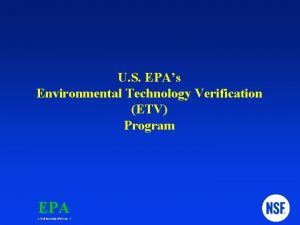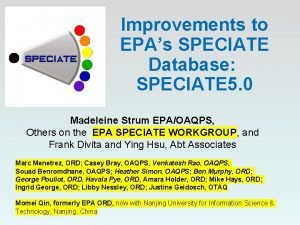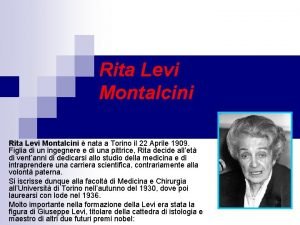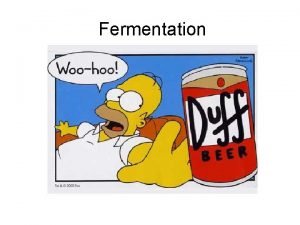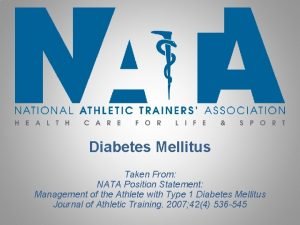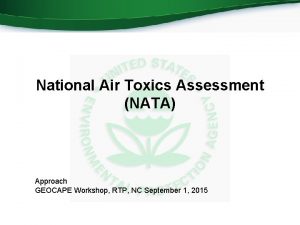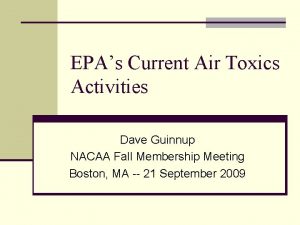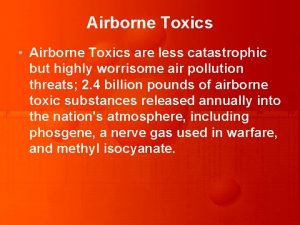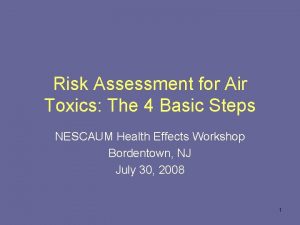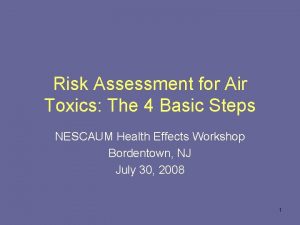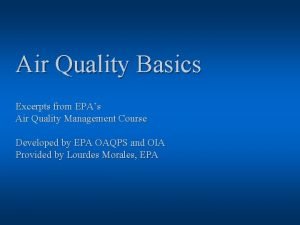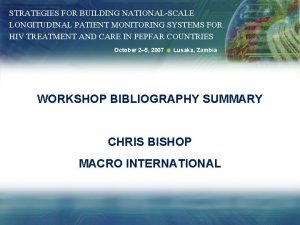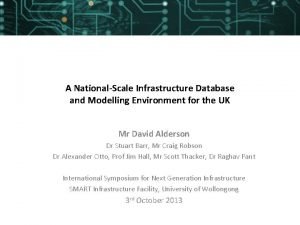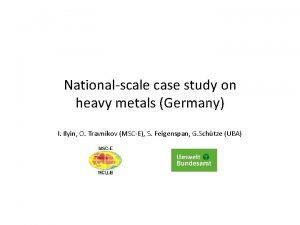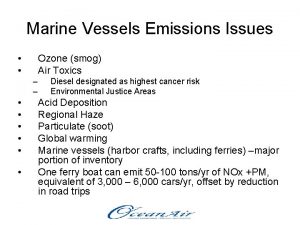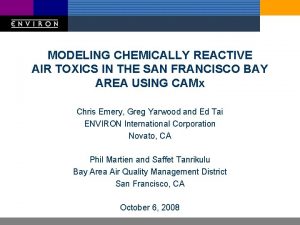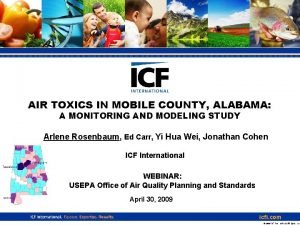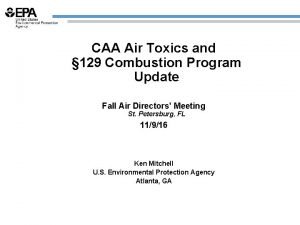INTRODUCTION TO EPAS NATIONALSCALE AIR TOXICS ASSESSMENT NATA




















- Slides: 20

INTRODUCTION TO EPA’S NATIONAL-SCALE AIR TOXICS ASSESSMENT (NATA) DATABASE Presentation to the Albuquerque-Bernalillo County Air Quality Control Board By Kathryn E Kelly, Dr. PH Delta Toxicology, Inc. 9 May 2018

Introduction to the EPA’s National-Scale Air Toxics Assessment (“NATA”) Database What Is NATA? What Kind of Data Are Presented? OVERVIEW Where Do the Data Come From? How Can NATA Be Used? How Should NATA Not Be Used? Can We Use It to Examine Cumulative Impacts? 2

What Is NATA? Started 1998 as the “Cumulative Exposure Project” with 32 Hazardous Air Pollutants (HAPs). Today, an in-depth screening and prioritization tool that displays emissions, monitoring, and risk data on a map, including: • Sources of 180 “air toxics” emissions • Air toxics monitoring data for 2005 to 2013 • Modeled annual ambient concentrations • Estimated cancer risks and respiratory hazard indices • From national-scale down to census tracts 3

Why Did EPA Create NATA? Identify those air toxics which are of greatest potential concern in terms of contribution to population risk. Guide efforts to cut air pollution. Build upon the already significant emissions reductions achieved in the US since 1990. Inform both national and localized efforts to collect air toxics information, characterize emissions, and help prioritize pollutants/geographic areas of interest for more refined data collection and analyses (e. g. , CSATM). 4

How Can NATA Be Used? • EPA’s Goal: Identify national and regional air toxics of greatest public health concern • Prioritize pollutants and emission source categories • Identify locations of interest for further investigation • Provide a starting point for local-scale assessments • Focus and prioritize community efforts and resources • Inform monitoring programs 5

Can NATA Be Used to Assess Cumulative Risks? Yes. “The national-scale assessment described in this document is consistent with EPA’s definition of a cumulative risk assessment, as stated in EPA’s Framework for Cumulative Risk Assessment as “an analysis, characterization, and possible quantification of the combined risks to health or the environment from multiple agents or stressors. ” The conceptual model defines the actual or predicted relationships among exposed individuals, populations, or ecosystems and the chemicals or stressors to which they might be exposed. ” NATA Technical Support Document, 2015 6

7

Cumulative Risk vs. Cumulative Impacts 1. What are the cumulative health risks from local air pollution? 2. Which cumulative risks exceed health or regulatory thresholds? ***If no thresholds are exceeded, there are no impacts to evaluate. *** _______________________________ 3. What are the cumulative impacts of exceeded thresholds? 4. What can be done to reduce impacts to below thresholds? 8

Four NATA Steps a 9

Compile Emissions Sources Large, permitted industry & gov’t “point” sources Small, multiple “non-point” (woodstoves, home heating, restaurants, gas stations, emergency generators, boilers) Fires (wild, prescribed, agricultural) Mobile (on- and off-road: trains, planes, automobiles, buses, trucks, lawnmowers) Secondary formation (atmospheric transformation) Biogenic sources (plants, trees, soil) Background concentrations (naturally occurring or longlasting) 10

Estimate Ambient Concentrations Fires Point Sources (Incl. Railyards) Airport E. g. , Benzene Exposure Concentration in Bernalillo County (2011, EPA NATA) Residential Wood Combustion Non-Point Low (e. g. , Gas Stations) Airplanes, Trains, Lawn Mowers, Construction Vehicles Non-Point 10 m Heavy-Duty (e. g. , Bulk Gas Vehicles Terminals) Cars, Trucks, Buses, Motorcycles 11

Estimate Population Risks from Outdoor Emissions Sources Cumulative Cancer Risk Cumulative Respiratory Hazard 12

NATA Conclusions The average, national cancer risk from air toxics is 40 in 1 million. ~1 in every 25, 000 people have an increased likelihood of contracting cancer as a result of breathing air toxics from outdoor sources if they were exposed to 2011 emission levels over the course of their 70 -year lifetime. 13

Air Toxics Cancer Risks Southwest 14

Air Toxics Cancer Risks: Louisiana Source: https: //gispub. epa. gov/NATA/ 15

16

NATA Conclusions National cancer risk driver: Formaldehyde Regional cancer risk drivers: Benzene, Chloroprene, Coke Oven Emissions _____ National noncancer hazard drivers: Acrolein (70%), Chlorine, Diesel PM. Regional noncancer hazard drivers: Hexamethylene Diisocyanate 17

The Fine Print: Limitations of NATA • • • • • Don’t compare results with past NATA databases; the methodology is continuously refined. The overall quality and uncertainties of the assessment will vary from location to location and from pollutant to pollutant. In many cases more localized assessments, including monitoring and modeling, may be needed to better characterize local-level risk. Gaps in data Limitations in computer models Default assumptions used routinely in any risk assessment Limitations in the overall design of the assessment (intended to address some questions but not others). Variations in detail and completeness of inventories from different geographical regions Results apply to geographic areas, not specific locations. Results do not include impacts from sources in neighboring countries (i. e. , Canada or Mexico). Results apply to groups, not to specific individuals. Results are restricted to the year of the analysis since emissions for that year were used. Results do not reflect exposures and risk from all compounds. Results do not reflect all pathways of exposure. Results reflect only compounds released into the outdoor air. Results do not fully reflect variation in background ambient air concentrations. Results might systematically underestimate ambient air concentration for some compounds. Results used default, or simplifying, assumptions where data were missing or of poor quality. Results may not accurately capture sources that have episodic emissions (e. g. , prescribed burning or facilities with short-term deviations such as startups, shutdowns, malfunctions, and upsets). Estimates of risk are uncertain. 18

NATA assessments should not be used for the following: • as a definitive means to pinpoint specific risk values within a census tract • to characterize or compare risks at local levels, such as between neighborhoods • to characterize or compare risks between states • to examine trends from one NATA year to another • as the sole basis for developing risk reduction plans or regulations • as the sole basis to control specific sources or pollutants, or • as the sole basis to quantify benefits of reduced air toxic emissions 19

Next Steps? • What does the Air Board want to know more about? • Conduct detailed NATA analysis of census tracts, emissions sources, and/or specific air toxics and health risk estimates for Bernalillo County? • Review EHD Community-Scale Air Toxics Monitoring and Risk Assessment Project? • Understand county emissions data? • Learn EPA’s process for conducting a Cumulative Risk Assessment? • Prepare additional analysis comparing air pollution to other health risk factors? 20
 Epas
Epas Epas enablers
Epas enablers Epas technologies
Epas technologies Herojinis
Herojinis Epas database
Epas database Pt tanah air sentosa
Pt tanah air sentosa Nata a torino nel 1909
Nata a torino nel 1909 Kelompok bioteknologi nata de koko
Kelompok bioteknologi nata de koko Rishta nata deutschland
Rishta nata deutschland Analisi di fratelli ungaretti
Analisi di fratelli ungaretti Nata de coco starter culture
Nata de coco starter culture Skema pembuatan nata de coco
Skema pembuatan nata de coco Nata code of ethics
Nata code of ethics Una corrente artistica statunitense
Una corrente artistica statunitense Nata lasmane
Nata lasmane Patrape adalah
Patrape adalah Timang iku kagawe saka
Timang iku kagawe saka Quali colombe dal disio chiamate
Quali colombe dal disio chiamate Nata position statement diabetes
Nata position statement diabetes Nata sickle cell
Nata sickle cell Nata de banana
Nata de banana


